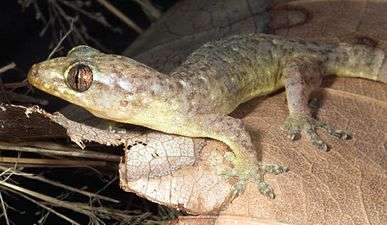Gehyra mutilata
Gehyra mutilata, also known as the common four-clawed gecko, stump-toed gecko, tender-skinned house gecko, sugar gecko, Pacific gecko, or butiki, is a type of house gecko that is native to Southeast Asia and Australia. It has made its way to several areas of the world including Sri Lanka, Indochina, and many of the Pacific Islands. Compared to common house geckos, this gecko's appearance is somewhat plump, with delicate skin. The skin is usually colored a soft purplish/pinkish gray with golden spots on younger specimens; these spots eventually fade with age.
| Gehyra mutilata | |
|---|---|
_from_Barangay_Dibuluan_-_ZooKeys-266-001-g046.jpg) | |
| Scientific classification | |
| Kingdom: | Animalia |
| Phylum: | Chordata |
| Class: | Reptilia |
| Order: | Squamata |
| Family: | Gekkonidae |
| Genus: | Gehyra |
| Species: | G. mutilata |
| Binomial name | |
| Gehyra mutilata (Wiegmann 1834) | |
| Synonyms | |
| |
Description
Head longer than broad; snout longer than distance between eye and ear-opening, about 1.3 times the diameter of the orbit; forehead with a median groove; ear-opening moderately large, suboval. Body and limbs moderately elongate, depressed, a fold of the skin bordering the hind limb posteriorly. Digits short, more or less webbed at the base; the inferior lamellae angular, divided by a median groove. Upper surface and throat covered with small granular scales, largest and flat on the back. Abdominal scales moderate. Rostral quadrangular, broader than deep, with a median cleft above; nostril pierced between the rostral, the first labial, and three nasals, the upper much the largest and generally in contact with its fellow; 8 or 9 upper and 6 or 7 lower labials; mental moderately large, pentagonal; chin-shields 3 pairs, inner very large, elongate, outer small, frequently broken up into small scales. Femoral pores in a doubly curved line, angular in the middle, 14 to 19 on each side. Tail depressed, normally with a sharpish, minutely serrated lateral edge; its upper surface covered with very small flat scales, its lower surface generally with a median series of large transversely dilated scales. Greyish or reddish brown above, uniform or dotted or variegated with darker; lower surfaces uniform whitish.[1]
From snout to vent 2.25 inches; tail 2.25.
Distribution

The species is widely distributed throughout Sri Lanka, Burma, Malaysia, Southeast China, The Philippines, Indonesia, New Guinea, French Polynesia, Pitcairn Islands, Mascarenes and Seychelles, Western Mexico, Maui, Hawaii.
Behavior
Like many other geckos, it is very adaptable to its surroundings, although it usually prefers woodlands, rocky areas, and human dwellings. It is also very common on sand beaches in Hawaii, where it is considered an invasive species. The geckos make themselves at home in people's houses, don't seem to mind the humans living beside them; many people don't mind the geckos either, perhaps because, being a nocturnally active species that spends much of its time high up on walls and ceilings; they are quite unobtrusive, and because they helpfully prey on household insects.
The species is fairly large for a gecko, reaching up to 12 cm. Its tail can reach almost the entire length of the body.
Like most house gecko species, the gecko is able to make chirping noises to communicate.
References
- Boulenger, G. A. (1890) Fauna of British India. Reptilia and Batrachia.